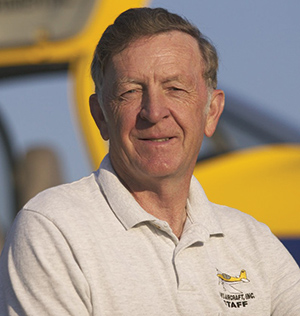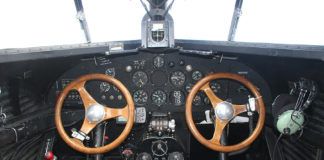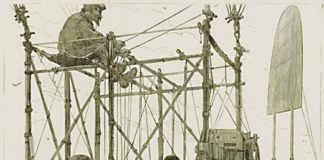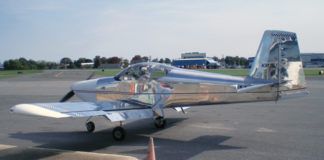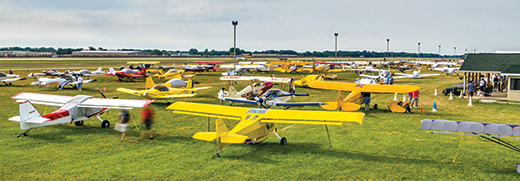

Well, the past year has been an interesting one in the kit aircraft world. There have been lots of changes, most for the good, and a number of new designs introduced—by our count 17 in all—with some reemerging after an absence, and others in development and very close to flying at press time. As some of you may know, one of our criteria has been that an airplane must have flown by AirVenture to be included in this guide. With our new Online Buyer’s Guide, this particular criterion is more flexible, because designs can be added during the year as they are introduced, but it is still a general benchmark.
This year we count 363 kit aircraft designs available total, up from 316 last year. Before you get too excited, part of this increase comes from a careful audit of the kit aircraft data, in which numerous designs had inadvertently been designated as “no longer available,” when in fact they were. Some of it also comes from counting iterations of an aircraft as a separate design, e.g., tailwheel or trigear versions. Still, even if you simply took the increase of 17 designs over the previous year’s count, that would mean just more than a 5% increase over last year’s number. Further, most of the companies that were in business last year remain in business, though some have discontinued certain designs to consolidate their offerings.
A word about our methodology in light of the new Buyer’s Guide format. As in years past, our process of updating the data is the same. Each manufacturer is contacted, via email or phone, and asked to review and update their aircraft listings. Any new information they provide is reflected in the complete Online Buyer’s Guide, bits of which are excerpted here. The Online Buyer’s Guide includes not only current designs but an archive of past designs (for more than 800 listings total, which is handy for used-aircraft buyers or those looking for partially completed kits). One of the many benefits of the new online format is that if we become aware of an error, omission, addition or change of status, we can update the database immediately rather than having to wait until the Buyer’s Guide season rolls around each year. This should keep the information more dynamic and current, and facilitate the comprehensive update that we will continue to conduct annually.
Caveat Emptor
As is true each year, whether for the print product or for the Online Buyer’s Guide, a couple of caveats are warranted. First, as mentioned, the data we have compiled is based on information supplied by the manufacturers. It is intended to be an introduction only, and is not a substitute for thorough pre-purchase research on a prospective buyer’s part. Ideally, that research would include at least a visit to the kit aircraft factory and a demo flight in the aircraft being considered. Something that looks good by the numbers may not be a good fit in reality, so it is always desirable to “try a plane on for size.” Further, though we do our best to thoroughly vet the data, the human factor is present in every aspect of putting these Buyer’s Guides together, and humans are inherently fallible. If you see an error, please let us know ([email protected]) and we will remedy it.
So, our approach in this new printed guide will be to present you with industry news that we have become aware of, along with not only a brief introduction to the new designs, but perhaps a look at some of the kit aircraft data from a new perspective. We will be featuring flight reviews on a number of the new designs presented, so we don’t want to give away the store, but consider this a “first look,” with a more rigorous investigation to come in future issues of the magazine. Complete information for all kit designs is, of course, available in the Online Aircraft Buyer’s Guide, with free, unlimited access for subscribers and limited access for newsstand readers. (See sidebar below for an explanation.)
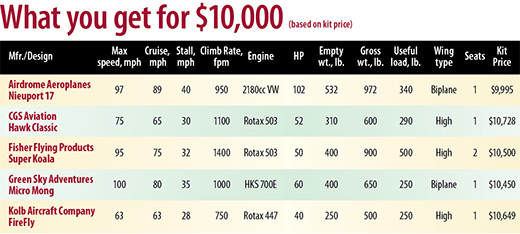
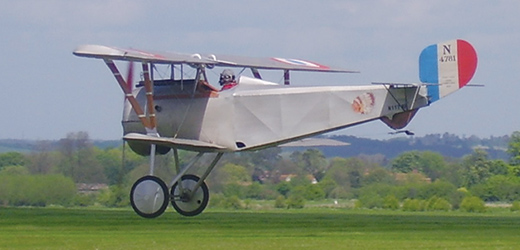
Airdrome Aeroplanes: Nieuport 17
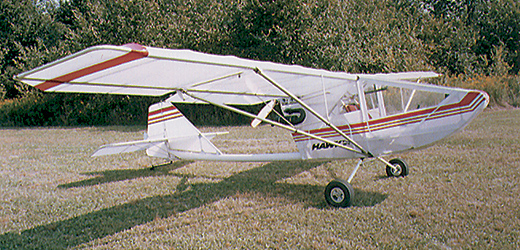
CGS Aviation: Hawk Classic
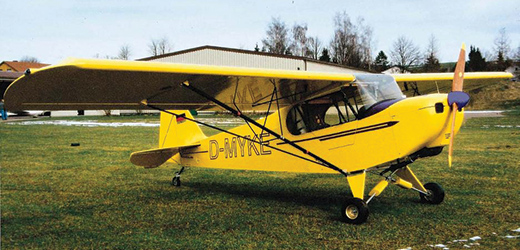
Fisher Flying Products: Super Koala
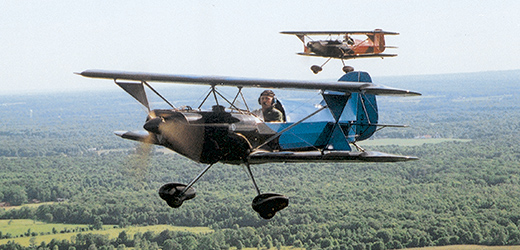
Green Sky Adventures: Micro Mong
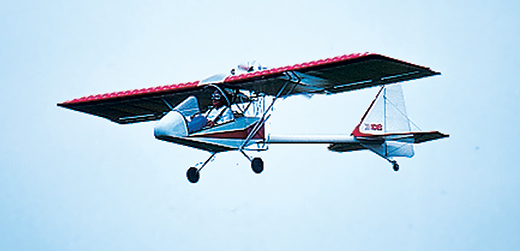
Kolb Aircraft Company: FireFly

And Now the News…
As regular readers may know, it was announced just before AirVenture that Glasair Aviation had been acquired by Chinese industrialist Fang Tieji, chairman of Jilin Hanxing Group, who announced his intentions to certify the Sportsman line of aircraft and acquire additional aviation companies. Former President of Glasair Mikael Via, who had been with the company since 2001, resigned on August 6. Via was responsible for developing the “Two Weeks to Taxi” program for the Sportsman, among other accomplishments. Former VP of Operations Nigel Mott was promoted to president, and Scott Taylor, formerly the general manager, is the new vice president of operations. The staff and ownership changes were expected to have a minimal impact on the employees, though Via said they “were excited about the possibilities” the new ownership would bring.
Quicksilver Manufacturing has new owners and a new name, Quicksilver Aeronautics. Says Will Escutia, president of Quicksilver Aeronautics, “We are working hard on several fronts to take charge of this storied company. Among those tasks is completely reversing the dealership program to make it more appealing.” The company is attracting new dealers in the U.S. and worldwide, Escutia says. Claiming more than 15,000 aircraft flying around the globe, the company will continue to operate from its current location in Temecula, California.
Another big news item that was announced just prior to AirVenture, though it had been in the works for some time, is the formation of the Aircraft Kit Industry Association (AKIA). The group was formed to promote homebuilt-aviation safety and was prompted, in part, by the NTSB’s study, report and recommendations concerning homebuilt-aircraft accident rates. (Find a complete analysis of the NTSB report by Ron Wanttaja on Page 36.) Current members include President Richard VanGrunsven, Vice President John Monnett and Secretary/Treasurer David Gustafson. Charter members at press time included Van’s Aircraft, Sonex, Zenith Aircraft, Kitfox Aircraft, Glasair Aviation, Lockwood Aviation, Lancair International, Arion Aircraft, Wag-Aero, Aircraft Spruce & Specialty, Wicks Aircraft, Dynon Avionics and Communication Resources. The organization is open to any company engaged in manufacturing kit aircraft or associated products. (Read a Q&A with AKIA President Richard VanGrunsven below.)

Hevle Aviation, which provided the Hevle Classic and 7⁄8 Stearman kits, has moved into selling plans only. We were unable to contact Johnston Aviation, purveyor of the Tiger Cub UL, so that kit is now considered unavailable (we figure if we can’t reach a company, you won’t be able to either). Lancair has consolidated its current designs to four: the Evolution Turbine, Evolution Piston, Lancair Legacy and Lancair Legacy FG. Only remaining stock will be sold for the rest. We were unable to track down Morrison Aircraft, maker of the Morrison 6, so it is considered not currently available. The same goes for National Aeronautics Company, maker of the Cassutt IIIM. Pro-Composites’ Vision EX kit is on hold pending retooling, but plans for it are available. Preceptor Aircraft Corporation’s N-3 Pup, Stinger, STOL King, Super Pup and Ultra Pup are no longer sold as kits but are available as plans. We were unable to get ahold of Quikkit Division of Rainbow Flyers, Inc., maker of the Glass Goose, so that design is considered unavailable. Sky Raider’s Sky Raider II kit is no longer being sold. Viper Aircraft is no longer providing kits for its ViperJet Mk II. Thunder Mustang is back in business under new ownership. BD-Micro Technologies has discontinued its BD-5J Microjet, BD-5T Turboprop and BD-5B. DFE Ultralights is no longer offering its Ascender 3A. Summit Aerosports also has a new name and new owners, and is the purveyor of the Summit SS, Summit 2, Steel Breeze and Mini Breeze; the last three are new listings.
The Aerolab Mfg. LoCamp has been returned to “Current” status, as has the Auriga Designs Inc. Aerocat SR (the Aerocat TR is not currently available). Comp Air Aviation expects its Comp Air 11 to be flying by the end of 2012, but development of the Comp Air Jet is halted for now, the company reports. The Comp Air 12 is available only as a certified aircraft for the time being, and the company is developing a Comp Air 14 certified freighter and Comp Air 16 certified twin freighter/passenger aircraft. The factory is also relocating from Merritt Island, Florida, to Melbourne, Florida.
New Aircraft
New designs this year include the Van’s RV-14, Velocity V-Twin, The Airplane Factory (new to the U.S.) Sling 2 and Sling 4, American Legend Super Legend, Bearhawk LSA, Belite UltraCub, Europa XS LSA Trigear, World Aircraft Vision, Mini-Max AeroMax, Kolb FireStar II SS, Just Aircraft Superstol, Aeroplanes DAR-23, the Summit Aerosports Summit 2, Steel Breeze and Mini Breeze, and the Synergy Paramotors Synergy (née Uptimal).
So, without further ado, let’s dig in.
Van’s Aircraft: RV-14
The debut of the RV-14 at AirVenture this year was nearly overshadowed by the induction ceremony for the original RV-1 into the EAA Museum. With great fanfare just before the ceremony, one each of the entire line of Van’s designs overflew the field, landed and taxied into the main square so that company founder Richard VanGrunsven (who had piloted the RV-1) could hand over the keys in a moving ceremony. There was nary a word about the new design. Still, the announcement of the RV-14 was one of those “open secrets” talked about in whispers, and it was greatly anticipated.
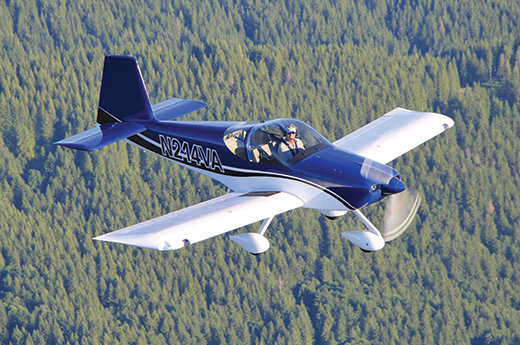
Van’s Aircraft: RV-14
At last count, Van’s had some 7842 airplanes flying, so one might wonder why the company would introduce a new design. The answer? “Because it was finished and market ready!” VanGrunsven said. The design process for the -14 actually started several years ago. The target builder, he said, is one who wants a comfortable, two-seat, cross-country sport plane with more baggage capacity than previous two-seaters. Aerobatic capability is another plus. The company reasoned that many builders who wanted a two-seat plane would enjoy the features of the RV-10, but without the cost, building and operating costs of a four-seater. The RV-14 expands the positive features of its predecessors (-6, -7 and -9). While none of those were lacking, VanGrunsven said, more is deemed better. For some larger pilots, the extra room of the -14 will add comfort.
The most important design considerations, VanGrunsven said, were: improved field of view (via increased cabin depth and a deeper canopy), modest landing speed despite the higher gross weight (via more effective flaps than used in the other two-seaters), good climb and glide performance despite the higher gross weight (achieved through a narrower-chord and greater-span wing than on the -7 and -8), an undercarriage that meets FAR 23 standards, increased cabin width, increased baggage space and capacity, and an airframe designed and tested to accommodate the Lycoming IO-390 engine.
Avionics will include two or three “plug-and-play” options based on the most popular EFIS choices on the market. A blank DIY panel will also be an option. Using the Van’s control module and overall wiring schematic, making minor changes to defined avionics packages should be easily achieved. Initially the Dynon SkyView system, similar to the RV-12, and as installed on the -14 prototype, will be available. Using the modular AV-50000 junction box, connection of any EFIS/avionics should be much more straightforward, even if the builder chooses something other than the factory-developed options, VanGrunsven said.
The -14 should also be easier to build thanks to pre-punched and pre-formed fuselage longerons, pre-installed wiring, the aforementioned plug-and-play avionics, pre-trimmed canopy and more precisely welded canopy frame, pre-fit engine baffles, full wiring harnesses with connectors, detailed step-by-step assembly instructions similar to the RV-12’s, numerous holes in the matched parts pre-punched to final size, and pre-punched landing-light holes.
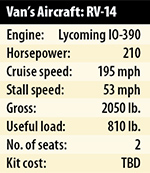
Van’s will also offer transition training for new builder/pilots, and the company has already begun construction of an airframe to be used for this purpose. “We don’t always do transition training in the identical model that the student will eventually be flying,” VanGrunsven said. “But we train in models with very similar features and handling characteristics, so the student is adequately prepared. For instance, we use an RV-7 to train pilots to fly their RV-8 because the RV-8 is not configured to be a practical trainer. Also, even when training is on the same model which the student will be flying, differences in engine horsepower and propellers (fixed pitch versus constant speed) affect the performance and handling. The transition-training instructor takes this into consideration when preparing the student.”
Velocity: V-Twin
As Duane Swing of Velocity Aircraft sees it, there has been an ongoing controversy about twin-engine aircraft because failure of one engine in a twin can result in a dangerous stall-spin, and single-engine failures are so rare that having two engines is not deemed worth the risk, additional expense and higher operating (and insurance) costs. However, he said, engine failures in a twin are rarely reported, because most pilots land successfully on one engine, and an engine-out problem on a twin can be managed with proper training.
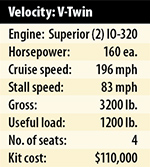
Although there is something to be said for each of these positions, Swing, who has spent a good deal of time in both singles and twins, summarized his position thusly: “My wife will not fly with me in a single-engine airplane, day or night.” That in itself, he said, was reason enough to forge ahead with the V-Twin aircraft.
With regard to those twin-related issues mentioned above, Swing offered the following solutions: First, the V-Twin’s canard design prevents main-wing stall and consequently the stall-spin if one engine fails. Lower insurance rates should result from this. Operating costs are reduced due to flying LOP (lean of peak) and maintenance costs are also lowered.
In order to achieve greater efficiency, the IO-320 engines are equipped with ElectroAir electronic ignition systems, cold-air induction and balanced fuel injectors, allow an economy cruise LOP fuel burn of just 6 gph per engine (12 gph total). This is equal to 20 mpg (road miles) while traveling 200 mph, Swing says. At 76% power, LOP fuel burn is just 8 gph per engine (16 gph total).
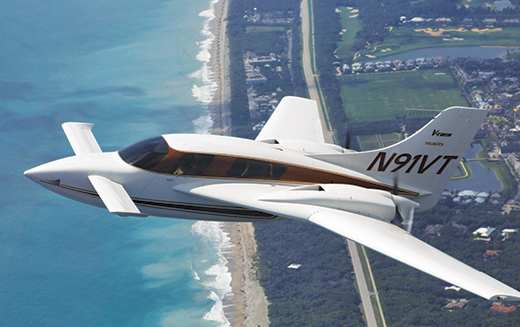
Velocity: V-Twin
Inspiration for the V-Twin came in part from the Twin Comanche, which Swing claims is about the most efficient of all of the light twins and represents the closest comparison he could find, as both use the 160-hp IO-320 engine and both start with a four-place configuration. The V-Twin, however, has a 4-inch-wider fuselage.
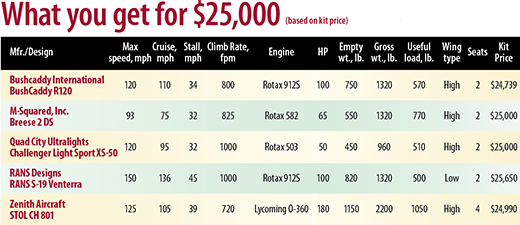
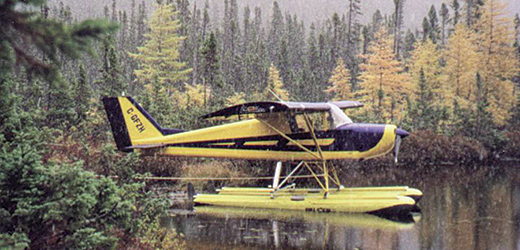
Bushcaddy International: BushCaddy R120
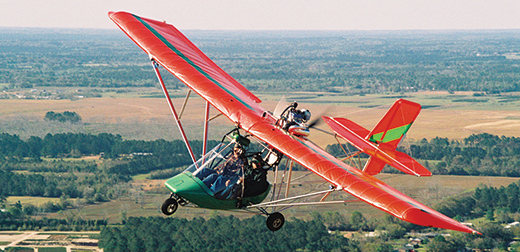
M-Squared, Inc.: Breese 2 DS
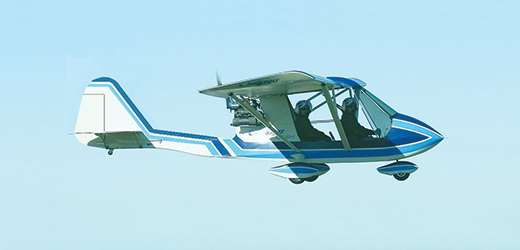
Quad City Ultralights: Challenger Light Sport XS-50
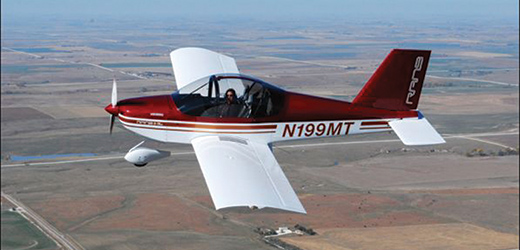
RANS Designs: RANS S-19 Venterra
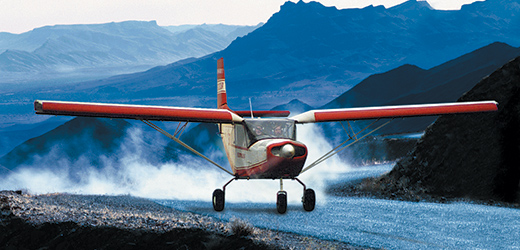
Zenith Aircraft: STOL CH 801
The Airplane Factory: Sling 2 (and Sling 4)
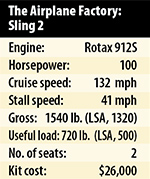
Those of you who attended AirVenture in 2009 or are avid followers of round-the-world travel in a homebuilt may remember the Sling from South Africa. Mike Blyth, who has designed numerous ultralights and trikes, got it in mind to create an LSA that was larger, faster and more substantial than his trike-type predecessors, and it would be made of aluminum.
Development of the original Sling began in 2006, and in 2012 The Airplane Factory received its airworthiness certificate for the first Sling LSA. So far, more than 60 airplanes have been delivered worldwide, and a U.S. distributor was established this year. It will also be available as an ELSA kit or an Experimental/Amateur-Built kit. That first Sling, N511NG, is based at Torrance Airport (KTOA) in California. A sliding canopy helps keep things cool. The company says a Rotax-914 turbo-powered Sling 4 will be available early next year.
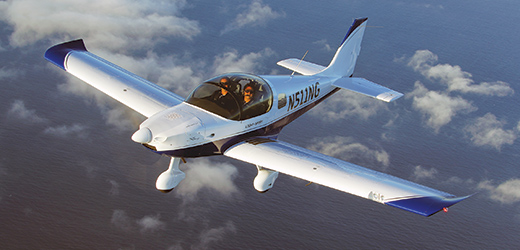
The Airplane Factory: Sling 2
American Legend: Super Legend
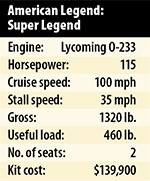
The Super Legend from American Legend, announced at Sun ’n Fun 2011, is another of those hotly anticipated designs, and the desire to see the prototype was finally requited at AirVenture this year. The Super Legend builds on its predecessor, the Legend Cub, adding features and options. Powered by a 115-hp Lycoming O-233 multi-fuel engine, the Super Legend also sports a new, flapped wing and Super Cub tail feathers for a sturdy back-country machine. Doors, the cowling and the interior panels are carbon fiber. An adjustable body-conforming seat adds to comfort. The Super Legend also has a 3-inch-wider cabin, standard double doors and the ability to solo from the front or rear seat.
“With the same power-to-weight ratio of a traditional Super Cub, the new Super Legend is an outstanding performer,” said Darin Hart, American Legend president. New features include an external baggage door, a folding and removable rear seat, and a fully adjustable front seat. With 32 gallons of fuel capacity and the Lycoming O-233 engine, the airplane has 5 hours of endurance, plus reserve. The O-233 can also use avgas, offering longer-term fuel alternatives.
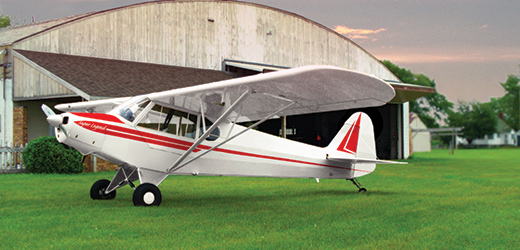
American Legend: Super Legend
Various paint schemes, interiors, lighting packages, tires, instrument packages, Smart Cub Panel (Dynon SkyView and Garmin G3X systems) and floats packages are among the numerous options.
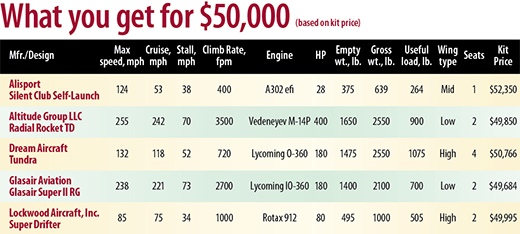
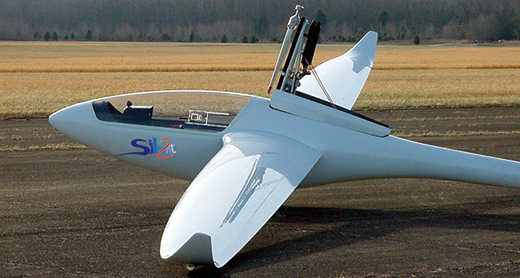
Alisport: Silent Club Self-Launch
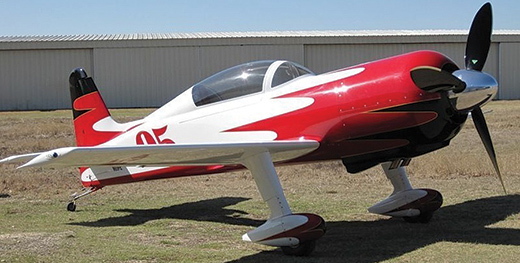
Altitude Group LLC: Radial Rocket TD
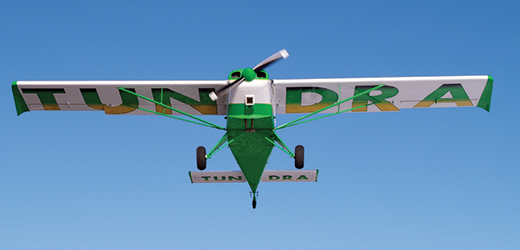
Dream Aircraft: Tundra
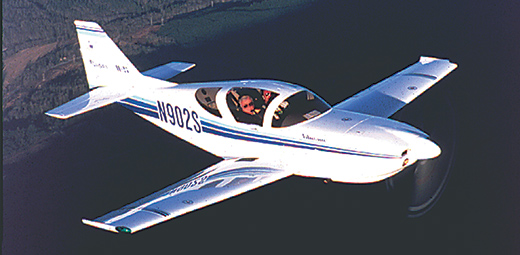
Glasair Aviation: Glasair Super II RG
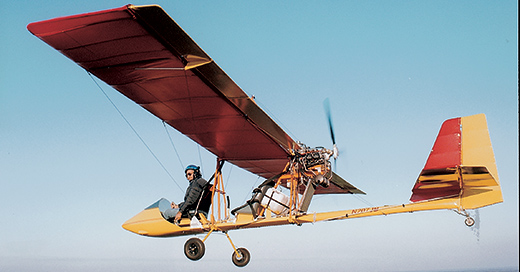
Lockwood Aircraft, Inc.: Super Drifter
Bearhawk Aircraft: Bearhawk LSA
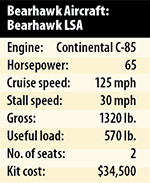
The newest product of well-known designer Bob Barrows, the Bearhawk LSA, also made its debut at AirVenture this year. Developed to be a lighter aircraft than Barrows’ four-place Bearhawk and two-place Bearhawk Patrol, the Bearhawk LSA lets current or future Sport Pilots in on the pleasures of the Bearhawk clan. Although it may look similar, the Bearhawk LSA is a clean-sheet design with an all-new airfoil designed in part by Harry Riblett. Construction is similar to other Bearhawks, with the fuselage and tail surfaces using the traditional 4130 chrome-moly tube-and-fabric design. The wings are an all-aluminum, flush-riveted design with a single strut.
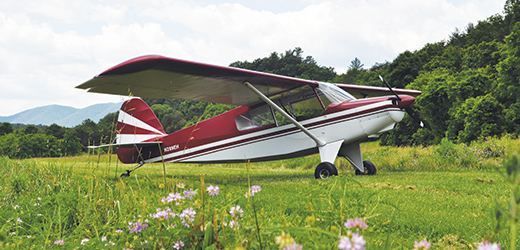
Bearhawk Aircraft: Bearhawk LSA
The prototype empty weight is about 720 pounds with an aluminum prop and no electrics, a realistic weight for builders who work to keep the airplane light, Barrows said. The airplane is really built for a maximum weight of 1500 pounds, he said, so there’s a built-in margin with the 1320-pound LSA limit. Economy cruise is about 100 mph, burning 4 gph with the 65-hp Continental engine. “Not many vehicles can produce 25 mpg at 100 mph,” Barrows said. A 120-mph cruise will burn about 6 gph.
Belite: UltraCub
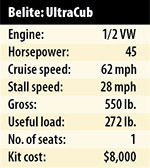
The UltraCub from Belite also made its first public appearance at AirVenture. The idea was to celebrate the 75th anniversary of Piper by creating this ultralight look-alike. This design differs from the company’s stock Belite ultralight in that the cabin is riveted aluminum and the pieces are pre-cut rather than pre-welded. Power is from a half-VW (two-cylinder) four-stroke engine. The wing has a full-span flaperon and “mini winglets.” The Dacron fabric for the aircraft is covered in an adhesive vinyl, which shortens fabrication time.
There are three lockers under the seat for storing incidentals. The turtledeck, which is a distinctive Cub-like feature, is removable (this option is available for a price in addition to the kit price). The kit also does not contain maingear springs, brakes or a fuel tank.
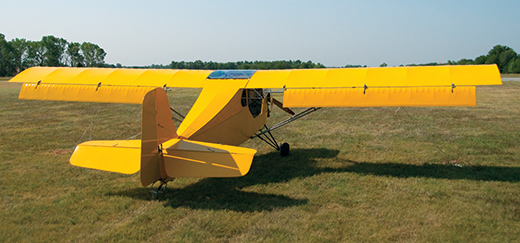
Belite: UltraCub
Europa Aircraft: Europa XS LSA Trigear
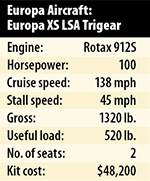
Europa announced an addition to its lineup this year, the Europa LSA, a two-seat composite monoplane with “advanced aerodynamics,” the company says. Europa says the LSA doesn’t lose any of the handling characteristics of the Europa XS, but it’s more comfortable, quicker in climb and comparably more economical to operate. The wings can easily be removed so it can be stored on a trailer in a garage.
Among the features attributed to the LSA are a fast climb rate, about 1300 fpm, range of about 500 n.m., fuel burn on economy settings of about 2 gph, generous useful load, excellent visibility, simple construction and maintenance, and ease of transport (no hangar fees if stored at home, wings removed, and on a trailer). A quickbuild option is standard on all kits. Europa can also install the cockpit module for builders before the kit leaves the factory (for an additional charge).
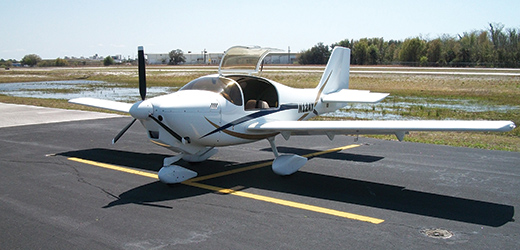
Europa Aircraft: Europa XS LSA Trigear
World Aircraft Company: Vision
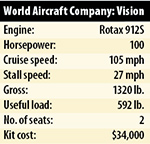
The all-metal construction Vision ELSA was announced at Sun ’n Fun this past spring, in Lakeland, Florida. The idea, the company said, was to create a great STOL aircraft. In addition to that goal, they wanted features that would provide maximum benefit to customers. Those include excellent visibility, especially forward and down, overly large doors for easy entry and exit, a large cabin (48.5 inches wide), easily adjustable seats to accommodate both short and tall pilots, full elevator control at steep angles of attack—especially in landing configuration—for easy landings, electric rudder trim to compensate for aggressive takeoffs, strong landing gear with an adjustable nosestrut shock absorber to “soak up” rough terrain, and a roomy engine compartment for ease of access and maintenance.
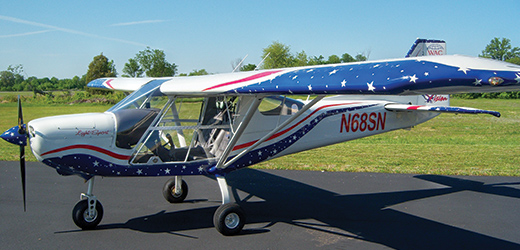
World Aircraft Company: Vision
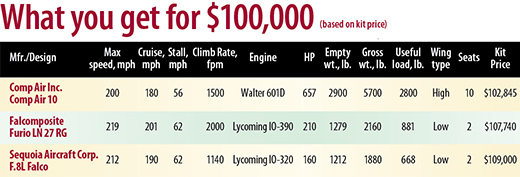
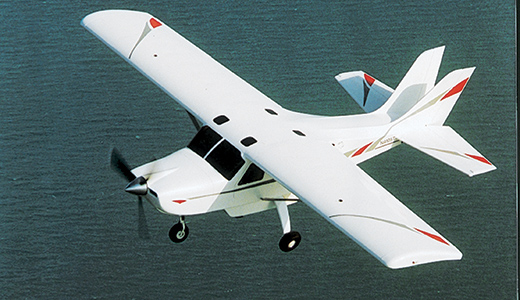
Comp Air Inc.: Comp Air 10
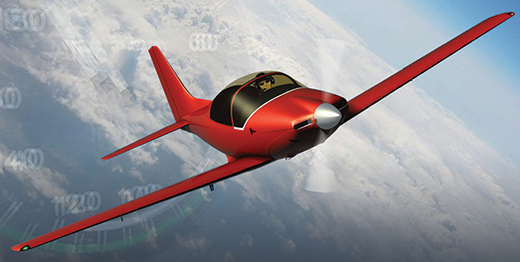
Falcomposite: Furio LN 27 RG
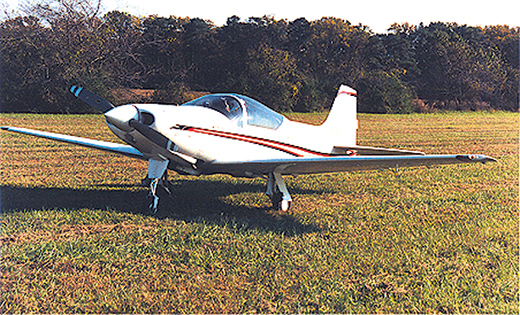
Sequoia Aircraft: F.8L Falco
Quick Takes on More New Designs
Aeroplanes: DAR-23
The two-place DAR-23 can be controlled from either of its side-by-side seats. It features new metal wings with composite flaperons that keep the total weight of the plane low (750 pounds). The DAR-23 also has a composite beam, pod and main landing gear. The landing gear is pyramidal with an elastic cord.
Push-pull cables control the ailerons and elevator; the controlled trim over the elevator is controlled by an electrical system. The connected nosewheel is operated with the vertical rudder. The Hirth F-23 engine comes standard, but the Rotax 503 or 582 can also be used.
According to the company, kit assembly take less than 350 hours; a quickbuild kit is available.
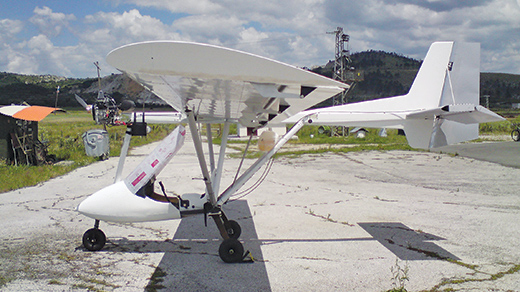
Just Aircraft: Superstol
Just Aircraft’s Superstol is the latest iteration of their Highlander, a two-place, side-by-side bush plane. Equipped with a Rotax 912S (or a Rotax 912, Jabiru 2200 or 3300, or a VW), the Highlander boasts takeoff and landing distances of 300 feet or less.
The new Superstol, which can also use a Rotax 914, offers a wing with automatically deploying leading-edge slats, as well as long travel landing gear and a new horizontal tail, which reduce those Highlander landing distances by as much as 50%, according to the company web site. The Superstol’s shock-absorber gear is fitted with 29-inch Tundra tires that assist with those very aggressive landings.
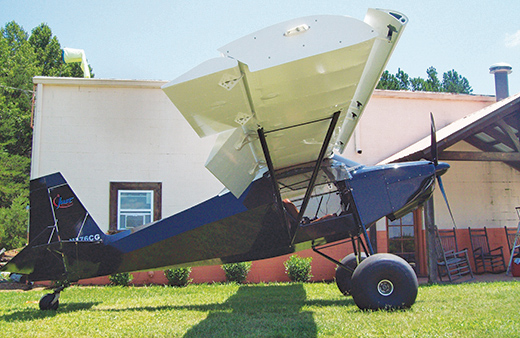
Kolb Aircraft: FireStar II SS
The FireStar II SS (the side-by-side version of the FireStar II) is an open-cockpit, high-wing, ultralight aircraft with unusual versatility: “It can be flown either as a taildragger or a trike; it converts back and forth,” said Kolb Aircraft’s Travis Brown. “We’re getting a lot of great response about it—people like to be able to change.”
It’s most often built with the Rotax 503 engine (the Rotax 582 engine is also an option); with the 503, cruise speed is 68 mph (top speed 80 mph). Because of the plane’s light weight, considerable wing area and large-diameter propeller, it’s able to operate from many types of improved fields.
The FireStar II SS (like all Kolb aircraft) uses traditional cable and push-pull tube controls, and its folding wings and tail make for easy storage or trailering. Everything stores on the airframe; one person can fold the tail up and the wings back along the fuselage in about 15 minutes.
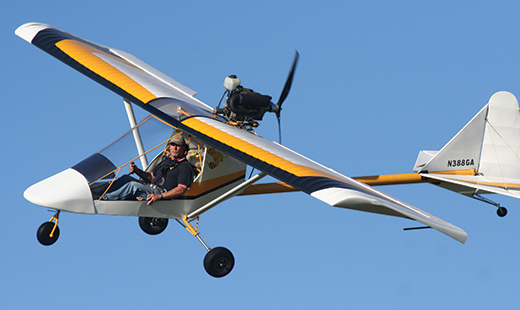
Mini-Max: AeroMax
The AeroMax is a direct descendent of the company’s popular Airbike design, according to David Cooper, director of operations for Mini-Max.
Powered by the Hirth F-23 engine, the AeroMax is an open-cockpit, high-wing, ELSA-compliant aircraft with a top speed of 75 mph. The plane can be built in about 200-300 hours, thanks to the work done on the manufacturer’s side. “The AeroMax is all laser-cut—not many kits are,” Cooper said. “And the hardware is all pre-machined for you, so there’s no grinding needed.”
It’s a single-seat aircraft (according to the company’s web site, “the pilot doesn’t just sit in a cockpit, he/she ‘wears’ the aircraft”), but the company is in the process of developing a tandem. The AeroMax comes with standard landing gear, but the company is also working on a one-piece aluminum landing gear, as well as floats. They are introducing $100-build kits, so builders can pay as they go, starting with just $100. Those kits should be available by the end of the year, according to Cooper.
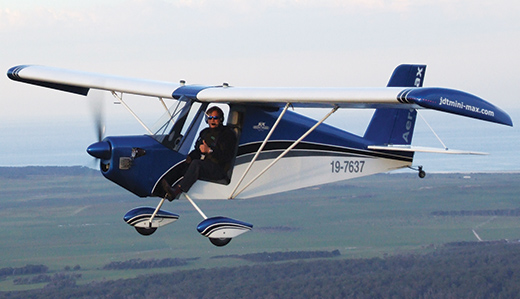
Summit Aerosports: Summit 2, Steel Breeze and Mini Breeze
The powered-parachute kits from Summit Aerosports are pre-drilled and pre-jigged; for builders, completing a Summit kit is as easy as inserting bolt A into hole B, and no welding is required, the company says. Anodized airframes, slider foot controls and tricycle landing gear are some shared features of their powered parachutes.
The two-seat Summit 2 can be powered by the Hirth 2706; the Rotax 503, 912 or 582; or the HKS 700E. With a fuel capacity of 10 gallons and a glide ratio between 4:1 and 6:1, its rate of climb is estimated at 400-800 feet per minute, depending on gross weight. The Summit 2’s airspeeds are in the 26-35 mph range, but when flying with an elliptical canopy instead of a rectangular one, speeds can reach up to 40 mph.
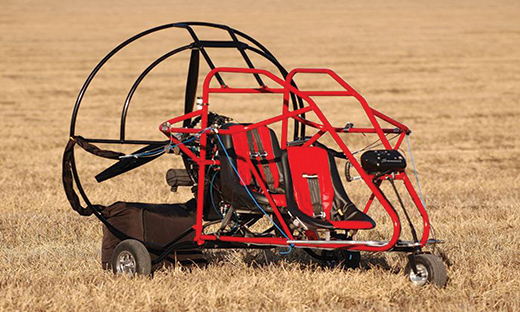
The Steel Breeze has two seats, 8-inch Azusa aluminum mag wheels and a 64-inch GSC Tech 3 ground-adjustable propeller. A variety of engines will fit: a Rotax 503 or 582, a Hirth 3503 or HKS 700E. Cruise speed is 25-35 mph, again with elliptical wings flying 6-10 mph faster, depending on weather conditions and gross weight. Glide ratios and climb rates are the same as those of the Summit 2; the fuel cell of the Steel Breeze has a 14-gallon capacity. The Steel Breeze has everything in place to be Sport Pilot compliant. The weight of the airframe alone is 227 pounds.
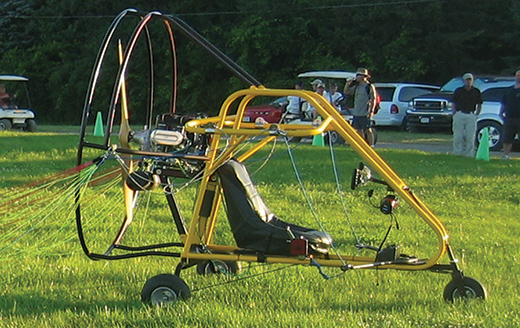
The airframe-only weight of the smaller, single-place Mini Breeze is 145 pounds. This parachute can be powered by the Rotax 447 DCDI or the Rotax 503 DCDI engines. Cruise speeds, glide ratios and climb rates are the same as those of the other models; the Mini Breeze uses a GSC fixed-pitch propeller, but ground-adjustable props are also an option.
Synergy Paramotors: Synergy (née Uptimal)
This powered paraglider uses a 49-inch propeller to maximize thrust as well as engine efficiency: Bigger propellers mean better performance, reduced noise and extended engine life—and an all-around more pleasant flight, according to the company’s web site.
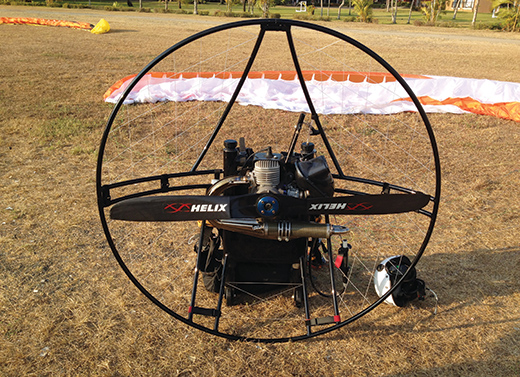
The single-seat Synergy has a thumb-activated throttle and cruise control (also available for left-handed pilots) and a weight-shift system. A high center of mass makes ground-handling of the Synergy prior to takeoff and upon landing easy (as do the wheels on the frame). Engine options include the Snap EGO and the C-Max 175.
In just a couple of minutes, the Synergy’s frame and cage can be broken down into a few parts that will fit into a 32x24x18-inch space (such as the trunk of most compact cars). Reassembly only requires the fastening of its nine high-strength Velcro straps.
What’s Coming?
There are always designs on the horizon that give us something to look forward to, and we’ll talk about a couple of them here. The all-metal two-seat (tandem) SAM LS from Haim Aviation in Quebec may very well be flying by the time you read this. Indeed, the company said at AirVenture that the prototype would fly by year’s end. Described as a “modern retro LSA,” the SAM seeks to capitalize on the looks of Golden Age aircraft; however, the key is the modern construction technology that underlies the classic look. The ailerons are mass balanced to inhibit flutter, and the elevator and rudder are mass balanced and aerodynamically balanced. Three different wing configurations will be offered: LS, STOL and CC (Experimental).
Word had it at AirVenture that the Pipistrel Panthera would be available soon. Some of you may know the name Pipistrel from its record-winning effort at the most recent Green Flight Challenge with the Pipistrel Taurus. The Panthera, which is a highly efficient four-place airplane, may first be offered as a kit and then as a certified design. Three versions are reportedly in the works: a gasoline-powered version along with two other versions, one with a 145-kW hybrid power system, and the other with a 145-kW pure electric system. These last two versions will seat only two people. The airframe will be all composite.
And there you have it. As mentioned, a complete listing of both current and archive designs is available at www.kitplanes.com/aircraftdirectory. Access is free for subscribers. We’ve put a good deal of effort into making the Online Buyer’s Guide a more useful and relevant resource, and we encourage you to take a look.

